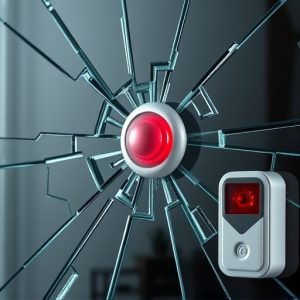Cost Analysis of Glass Break Alarm Sensor Technologies
Glass break alarm sensors are essential components of modern security systems that accurately detect…….
Glass break alarm sensors are essential components of modern security systems that accurately detect the acoustic signatures of breaking glass. These sensors are finely-tuned to the frequency range typical of glass fracture noises (2 to 5 kHz) to minimize false alarms and respond promptly to actual incidents. They are widely used across residential, commercial, and high-security spaces, including vehicles, triggering both local alarms and signals to security personnel or monitoring services for a comprehensive security network. The cost of these sensors varies based on technology, brand prestige, features, range, integration capabilities, and smart home compatibility. Consumers should consider the reliability, durability, and compatibility of a sensor within their smart home ecosystem, as well as warranty and additional services offered by the brand. A wide range of options is available, from entry-level detectors under $50 to sophisticated commercial systems costing over $150. Professional installation is recommended for optimal performance and safety compliance. Ongoing maintenance, including regular testing, battery checks, and cleaning, should be factored into the long-term budget alongside potential repair costs and monitoring fees. Selecting a durable sensor can help manage future maintenance and upgrade expenses effectively.
When safeguarding your property against intruders, a glass break alarm sensor stands as a vigilant sentinel. This article demystifies the technology behind these devices, their practical applications, and the multifaceted cost implications. From the innovative mechanisms that detect the acoustic signature of breaking glass to the varied pricing structures of different brands and models, we explore it all. Additionally, we delve into the long-term investment aspects, including installation and maintenance costs. Whether you’re a homeowner or a business proprietor, understanding the factors that influence the price of glass break alarm sensors is key to making an informed decision for your security needs.
Understanding the Glass Break Alarm Sensor Technology and Its Application
Glass break alarm sensors represent a critical component in security systems, designed to detect the sound frequencies characteristic of breaking glass. These sophisticated devices are engineered to distinguish between the specific acoustic signature of glass fracturing and other sounds, thereby providing an early warning in the event of unauthorized entry or tampering. The technology behind these sensors involves microphones that are highly sensitive to vibrations within the 2 to 5 kHz range, which is the typical frequency at which glass breaks. This sensitivity allows for precise activation, reducing false alarms while ensuring timely response to actual breakage events.
The application of glass break alarm sensors extends beyond residential security systems; they are also prevalent in commercial establishments, automobiles, and sensitive facilities that require high levels of security. Their integration into broader security networks enables a multi-layered defense mechanism, where the activation of a glass break sensor can trigger not only a local alarm but also a remote alert to security personnel or monitoring services. This prompt detection capability is instrumental in deterring intruders and enhancing personal and property safety. Additionally, advancements in sensor technology have led to variations that cater to different noise environments, ensuring reliability across diverse settings, from quiet homes to noisy urban environments.
Factors Influencing the Cost of Glass Break Alarm Sensors
The cost of glass break alarm sensors can vary based on several factors, which include the technology employed, brand reputation, and the specific features offered by each sensor. Advanced sensors that utilize more sophisticated sound detection algorithms to differentiate between the sound of breaking glass and other noises tend to be more expensive due to their increased complexity and accuracy. These systems can detect a wide range of frequencies characteristic of glass breakage, ensuring fewer false alarms. Additionally, sensors with longer ranges or those capable of integrating seamlessly with existing home security systems may command higher prices. Consumers should consider the reliability and durability of the sensor, as well as its compatibility with smart home ecosystems, which can add to the overall cost but also provide enhanced functionality and convenience. Brand recognition and warranty terms are additional factors that influence pricing, as reputable brands often offer longer warranties or additional services, reflecting in the product’s cost. When selecting a glass break alarm sensor, it is advisable to weigh these factors against your specific security needs and budget constraints to find a suitable balance between cost and functionality.
Comparing the Prices of Different Glass Break Alarm Sensor Brands and Models
When considering the acquisition of a glass break alarm sensor, discerning consumers are often interested in the pricing spectrum across various brands and models to find the most cost-effective solution that meets their security needs. The market offers a range of glass break detectors, from budget-friendly options designed for small residential windows to advanced systems with sophisticated technology suitable for larger premises or commercial use. For instance, entry-level models from well-known manufacturers like Abode and SimpliSafe might start at around $20 to $50, offering basic functionality and integration with other smart home devices.
Mid-range options from brands such as Honeywell and Brink, typically priced between $60 and $120, often include additional features like adjustable sensitivity settings and pet immune capabilities, ensuring that the alarm is activated only by the sound of breaking glass rather than harmless noises. At the higher end of the market, premium models from manufacturers like Finedge or Honeywell’s more advanced systems can exceed $150, providing top-tier performance with enhanced detection algorithms and higher durability for commercial applications. It is advisable to compare these prices across different retail channels, including online stores and local security system providers, to secure the best deal while ensuring optimal protection for your home or business.
Installation, Maintenance, and Long-Term Cost Considerations for Glass Break Alarm Systems
When considering the installation of a glass break alarm sensor, it’s a process that typically requires professional expertise. While some systems are designed for do-it-yourself (DIY) setups, ensuring optimal performance and compliance with safety standards is often best left to security professionals. They can accurately place sensors on or near windows and doors, which is crucial for detecting the specific sound frequencies emitted when glass breaks. Post-installation, regular maintenance is necessary to keep these systems operational. This includes periodic testing of the alarm to ensure it responds as intended, checking sensor batteries, and cleaning any dust or debris that might interfere with its sensitivity. Maintenance frequency can vary depending on usage and environmental factors, but generally, a biannual check is recommended.
Long-term cost considerations for glass break alarm sensors encompass not only the initial purchase price but also the ongoing operational expenses. While the sensor itself may have a moderate upfront cost, the true expense manifests over time through battery replacements, potential repair needs if damage occurs, and monitoring fees if the system is connected to a security service provider. It’s advisable to inquire about these costs at the time of purchase and factor in long-term maintenance when budgeting for home security. Additionally, considering the sensor’s lifespan and technological advancements can help anticipate future expenses for upgrades or replacements. Opting for a system with a reputation for durability and reliability may mitigate some of these costs over the years.


